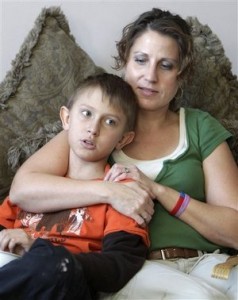 Dave Hisey’s oldest daughter, diagnosed with leukemia nearly five years ago when she was 13, is in remission. His 12-year-old son has another year of chemotherapy for a different type of leukemia. And his 9-year-old daughter is scared she’ll be next. Hisey is not alone in fearing the worst. Just about every mom and dad in this rural northern Ohio town gets nervous whenever their children get a sinus infection or a stomachache lingers. It’s hard not to panic since mysterious cancers have sickened dozens of area children in recent years.
Dave Hisey’s oldest daughter, diagnosed with leukemia nearly five years ago when she was 13, is in remission. His 12-year-old son has another year of chemotherapy for a different type of leukemia. And his 9-year-old daughter is scared she’ll be next. Hisey is not alone in fearing the worst. Just about every mom and dad in this rural northern Ohio town gets nervous whenever their children get a sinus infection or a stomachache lingers. It’s hard not to panic since mysterious cancers have sickened dozens of area children in recent years.
Since 1996, 35 children have been diagnosed — and three have died — of brain tumors, leukemia, lymphoma, and other forms of cancer — all within a 12-mile wide circle that includes two small towns and farmland just south of Lake Erie. With many of the diagnoses coming between 2002 and 2006, state health authorities declared it a cancer cluster, saying the number and type of diagnoses exceed what would be expected statistically for so small a population over that time.
After three years of exhaustive investigation, no cause is known. Investigators have tested wells and public drinking water, sampled groundwater and air near factories and checked homes, schools and industries for radiation.
They also set up a network of air monitors across eastern Sandusky County, finding cleaner air than in most places around Ohio, the health department said.
Nothing unusual was detected. Not even a hint.
“From the very beginning, we’ve said the vast majority of childhood cancer causes aren’t known,” said Robert Indian, the state health department’s chief of comprehensive cancer control. He’ll soon release yet another investigative report.
Eight children were diagnosed with cancer in and near Clyde between 2002-2006, nearly four times the number that state health experts figure is normal.
Ohio health investigators converged on the town of just 6,000 people halfway between Cleveland and Toledo and home to the Whirlpool Corp.’s largest washing machine factory.
What they found was worse than anyone suspected. The cancers affecting victims age 19 and younger included neighboring townships and much of the nearby town of Fremont.
One in five of the cancer cases were related to the brain or central nervous system, matching national rates, according to the American Cancer Society.
In September, investigators said they found no radiation from homes, schools, or industries to link to the illnesses, ruling out the Davis-Besse nuclear plant, about 20 miles from Clyde, and NASA’s former nuclear reactor near Sandusky as a possible source.
Doctors also have been vigilant, making sure they’re not missing any signs or symptoms in young patients. And parents are more likely to bring their kids in for checkups instead of waiting for an illness to go away.
Brandy Kreider, a mother of five children, said she and her husband spent an agonizing week and sleepless nights wondering if they were making a mistake before buying a new home in town two years ago. In the end, leaving didn’t feel right.
“Those things don’t want to make us retreat,” she said. “They bring us together.”
The Hiseys faced the same question almost five years ago when daughter Tyler Smith, who’s now 17, was diagnosed with acute myeloid leukemia.
They put their house up for sale even though it had everything they wanted: ponds for fishing, a woods for hunting and plenty of space. They’re now glad it didn’t sell.
The outdoors surrounding their home has become a sanctuary for Tanner, 12, diagnosed with acute lymphoblastic leukemia two years after his sister was sickened.
Chemotherapy has kept him out of school most of this year so home is where he spends much of his time. It’s where he can catch catfish, watch deer romp across the fields and still be a kid.
“Everything else has been taken away,” his father said. “We can’t take their support, their comfort and their home away from them.”